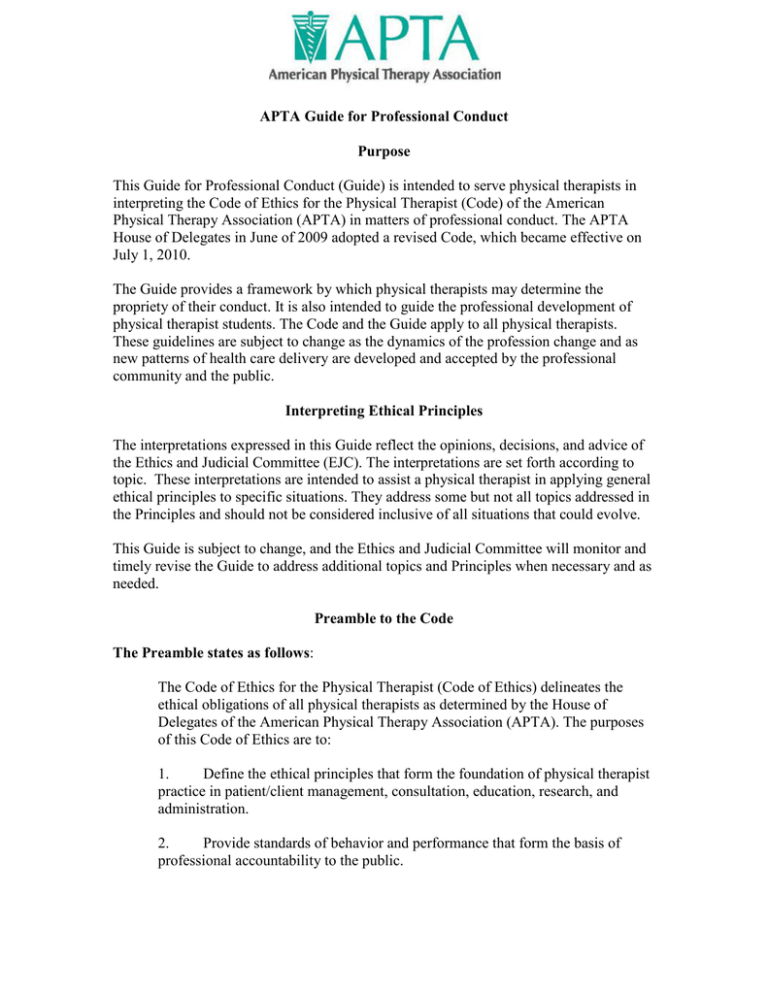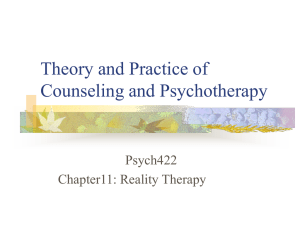This Guide for Professional Conduct (Guide) is intended to serve... interpreting the Code of Ethics for the Physical Therapist (Code)... APTA Guide for Professional Conduct
advertisement

APTA Guide for Professional Conduct Purpose This Guide for Professional Conduct (Guide) is intended to serve physical therapists in interpreting the Code of Ethics for the Physical Therapist (Code) of the American Physical Therapy Association (APTA) in matters of professional conduct. The APTA House of Delegates in June of 2009 adopted a revised Code, which became effective on July 1, 2010. The Guide provides a framework by which physical therapists may determine the propriety of their conduct. It is also intended to guide the professional development of physical therapist students. The Code and the Guide apply to all physical therapists. These guidelines are subject to change as the dynamics of the profession change and as new patterns of health care delivery are developed and accepted by the professional community and the public. Interpreting Ethical Principles The interpretations expressed in this Guide reflect the opinions, decisions, and advice of the Ethics and Judicial Committee (EJC). The interpretations are set forth according to topic. These interpretations are intended to assist a physical therapist in applying general ethical principles to specific situations. They address some but not all topics addressed in the Principles and should not be considered inclusive of all situations that could evolve. This Guide is subject to change, and the Ethics and Judicial Committee will monitor and timely revise the Guide to address additional topics and Principles when necessary and as needed. Preamble to the Code The Preamble states as follows: The Code of Ethics for the Physical Therapist (Code of Ethics) delineates the ethical obligations of all physical therapists as determined by the House of Delegates of the American Physical Therapy Association (APTA). The purposes of this Code of Ethics are to: 1. Define the ethical principles that form the foundation of physical therapist practice in patient/client management, consultation, education, research, and administration. 2. Provide standards of behavior and performance that form the basis of professional accountability to the public. 2 3. Provide guidance for physical therapists facing ethical challenges, regardless of their professional roles and responsibilities. 4. Educate physical therapists, students, other health care professionals, regulators, and the public regarding the core values, ethical principles, and standards that guide the professional conduct of the physical therapist. 5. Establish the standards by which the American Physical Therapy Association can determine if a physical therapist has engaged in unethical conduct. No code of ethics is exhaustive nor can it address every situation. Physical therapists are encouraged to seek additional advice or consultation in instances where the guidance of the Code of Ethics may not be definitive. This Code of Ethics is built upon the five roles of the physical therapist (management of patients/clients, consultation, education, research, and administration), the core values of the profession, and the multiple realms of ethical action (individual, organizational, and societal). Physical therapist practice is guided by a set of seven core values: accountability, altruism, compassion/caring, excellence, integrity, professional duty, and social responsibility. Throughout the document the primary core values that support specific principles are indicated in parentheses. Unless a specific role is indicated in the principle, the duties and obligations being delineated pertain to the five roles of the physical therapist. Fundamental to the Code of Ethics is the special obligation of physical therapists to empower, educate, and enable those with impairments, activity limitations, participation restrictions, and disabilities to facilitate greater independence, health, wellness, and enhanced quality of life. Interpretation: Upon the Code of Ethics for the Physical Therapist being amended effective July 1, 2010, all the lettered principles in the Code contain the word “shall” and are mandatory ethical obligations. The language contained in the Code is intended to better explain and further clarify existing ethical obligations. These ethical obligations predate the revised Code. Although various words have changed, many of the obligations are the same. Consequently, the addition of the word “shall” serves to reinforce and clarify existing ethical obligations. A significant reason that the Code was revised was to provide physical therapists with a document that was clear enough such that they can read it standing alone without the need to seek extensive additional interpretation. The Preamble states that “[n]o Code of Ethics is exhaustive nor can it address every situation.” The Preamble also states that physical therapists “are encouraged to seek additional advice or consultation in instances in which the guidance of the Code may not be definitive.” Potential sources for advice and counsel include third parties and the myriad resources available on the APTA Web site. Inherent in a physical therapist’s ethical decision-making process is the examination of his or her unique set of facts relative to the Code. 3 Topics Respect Principle 1A states as follows: 1A. Physical therapists shall act in a respectful manner toward each person regardless of age, gender, race, nationality, religion, ethnicity, social or economic status, sexual orientation, health condition, or disability. Interpretation: Principle 1A addresses the display of respect toward others. Unfortunately, there is no universal consensus about what respect looks like in every situation. For example, direct eye contact is viewed as respectful and courteous in some cultures and inappropriate in others. It is up to the individual to assess the appropriateness of behavior in various situations. Altruism Principle 2A states as follows: 2A. Physical therapists shall adhere to the core values of the profession and shall act in the best interests of patients/clients over the interests of the physical therapist. Interpretation: Principle 2A reminds physical therapists to adhere to the profession’s core values and act in the best interest of patients/clients over the interests of the physical therapist. Often this is done without thought, but sometimes, especially at the end of the day when the physical therapist is fatigued and ready to go home, it is a conscious decision. For example, the physical therapist may need to make a decision between leaving on time and staying at work longer to see a patient who was 15 minutes late for an appointment. 4 Patient Autonomy Principle 2C states as follows: 2C. Physical therapists shall provide the information necessary to allow patients or their surrogates to make informed decisions about physical therapy care or participation in clinical research. Interpretation: The underlying purpose of Principle 2C is to require a physical therapist to respect patient autonomy. In order to do so, a physical therapist shall communicate to the patient/client the findings of his/her examination, evaluation, diagnosis, and prognosis. A physical therapist shall use sound professional judgment in informing the patient/client of any substantial risks of the recommended examination and intervention and shall collaborate with the patient/client to establish the goals of treatment and the plan of care. Ultimately, a physical therapist shall respect the patient’s/client’s right to make decisions regarding the recommended plan of care, including consent, modification, or refusal. Professional Judgment Principles 3, 3A, and 3B state as follows: 3: Physical therapists shall be accountable for making sound professional judgments. (Core Values: Excellence, Integrity) 3A. Physical therapists shall demonstrate independent and objective professional judgment in the patient’s/client’s best interest in all practice settings. 3B. Physical therapists shall demonstrate professional judgment informed by professional standards, evidence (including current literature and established best practice), practitioner experience, and patient/client values. Interpretation: Principles 3, 3A, and 3B state that it is the physical therapist’s obligation to exercise sound professional judgment, based upon his/her knowledge, skill, training, and experience. Principle 3B further describes the physical therapist’s judgment as being informed by three elements of evidence-based practice. With regard to the patient/client management role, once a physical therapist accepts an individual for physical therapy services he/she shall be responsible for: the examination, evaluation, and diagnosis of that individual; the prognosis and intervention; reexamination and modification of the plan of care; and the maintenance of adequate records, including progress reports. A physical therapist shall establish the plan of care and shall provide and/or supervise and direct the appropriate interventions. Regardless of practice setting, a physical therapist has primary responsibility for the physical therapy care of a patient and shall make independent judgments regarding that care consistent with accepted professional standards. 5 If the diagnostic process reveals findings that are outside the scope of the physical therapist's knowledge, experience, or expertise or that indicate the need for care outside the scope of physical therapy, the physical therapist shall so inform the patient/client and shall refer the patient/client to an appropriate practitioner. A physical therapist shall determine when a patient/client will no longer benefit from physical therapy services. When a physical therapist's judgment is that a patient will receive negligible benefit from physical therapy services, the physical therapist shall not provide or continue to provide such services if the primary reason for doing so is to further the financial self-interest of the physical therapist or his/her employer. A physical therapist shall avoid overutilization of physical therapy services. See Principle 8C. Supervision Principle 3E states as follows: 3E. Physical therapists shall provide appropriate direction of and communication with physical therapist assistants and support personnel. Interpretation: Principle 3E describes an additional circumstance in which sound professional judgment is required; namely, through the appropriate direction of and communication with physical therapist assistants and support personnel. Further information on supervision via applicable local, state, and federal laws and regulations (including state practice acts and administrative codes) is available. Information on supervision via APTA policies and resources is also available on the APTA Web site. See Principles 5A and 5B. Integrity in Relationships Principle 4 states as follows: 4: Physical therapists shall demonstrate integrity in their relationships with patients/clients, families, colleagues, students, research participants, other health care providers, employers, payers, and the public. (Core Value: Integrity) Interpretation: Principle 4 addresses the need for integrity in relationships. This is not limited to relationships with patients/clients, but includes everyone physical therapists come into contact with professionally. For example, demonstrating integrity could encompass working collaboratively with the health care team and taking responsibility for one’s role as a member of that team. 6 Reporting Principle 4C states as follows: 4C. Physical therapists shall discourage misconduct by healthcare professionals and report illegal or unethical acts to the relevant authority, when appropriate. Interpretation: When considering the application of “when appropriate” under Principle 4C, keep in mind that not all allegedly illegal or unethical acts should be reported immediately to an agency/authority. The determination of when to do so depends upon each situation’s unique set of facts, applicable laws, regulations, and policies. Depending upon those facts, it might be appropriate to communicate with the individuals involved. Consider whether the action has been corrected, and in that case, not reporting may be the most appropriate action. Note, however, that when an agency/authority does examine a potential ethical issue, fact finding will be its first step. The determination of ethicality requires an understanding of all of the relevant facts, but may still be subject to interpretation. The EJC Opinion titled: Topic: Preserving Confidences; Physical Therapist's Reporting Obligation With Respect to Unethical, Incompetent, or Illegal Acts provides further information on the complexities of reporting. Exploitation Principle 4E states as follows: 4E. Physical therapists shall not engage in any sexual relationship with any of their patient/clients, supervisees or students. Interpretation: The statement is fairly clear – sexual relationships with their patients/clients, supervisees or students are prohibited. This component of Principle 4 is consistent with Principle 4B, which states: Physical therapists shall not exploit persons over whom they have supervisory, evaluative or other authority (e.g. patients/clients, students, supervisees, research participants, or employees). Next, consider this excerpt from the EJC Opinion titled Topic: Sexual Relationships With Patients/Former Patients: A physical therapist stands in a relationship of trust to each patient and has an ethical obligation to act in the patient's best interest and to avoid any exploitation or abuse of the patient. Thus, if a physical therapist has natural feelings of attraction toward a patient, he/she must sublimate those feelings in order to avoid sexual exploitation of the patient. 7 One’s ethical decision making process should focus on whether the patient/client, supervisee or student is being exploited. In this context, questions have been asked about whether one can have a sexual relationship once the patient/client relationship ends. To this question, the EJC has opined as follows: The Committee does not believe it feasible to establish any bright-line rule for when, if ever, initiation of a romantic/sexual relationship with a former patient would be ethically permissible. ….. The Committee imagines that in some cases a romantic/sexual relationship would not offend ... if initiated with a former patient soon after the termination of treatment, while in others such a relationship might never be appropriate. Colleague Impairment Principle 5D and 5E state as follows: 5D. Physical therapists shall encourage colleagues with physical, psychological, or substance-related impairments that may adversely impact their professional responsibilities to seek assistance or counsel. 5E. Physical therapists who have knowledge that a colleague is unable to perform their professional responsibilities with reasonable skill and safety shall report the information to the appropriate authority. Interpretation: The central tenet of Principles 5D and 5E is that inaction is not an option for a physical therapist when faced with the circumstances described. Principle 5D states that a physical therapist shall encourage colleagues to seek assistance or counsel while Principle 5E addresses reporting information to the appropriate authority. 5D and 5E both require a factual determination on your part. This may be challenging in the sense that you might not know or it might be difficult for you to determine whether someone in fact has a physical, psychological, or substance-related impairment. In addition, it might be difficult to determine whether such impairment may be adversely affecting his or her professional responsibilities. Moreover, once you do make these determinations, the obligation under 5D centers not on reporting, but on encouraging the colleague to seek assistance. However, the obligation under 5E does focus on reporting. But note that 5E discusses reporting when a 8 colleague is unable to perform, whereas 5D discusses encouraging colleagues to seek assistance when the impairment may adversely affect his or her professional responsibilities. So, 5D discusses something that may be affecting performance, whereas 5E addresses a situation in which someone is clearly unable to perform. The 2 situations are distinct. In addition, it is important to note that 5E does not mandate to whom you report; it gives you discretion to determine the appropriate authority. The EJC Opinion titled: Topic: Preserving Confidences; Physical Therapist's Reporting Obligation With Respect to Unethical, Incompetent, or Illegal Acts provides further information on the complexities of reporting. Professional Competence Principle 6A states as follows: 6A. Physical therapists shall achieve and maintain professional competence. Interpretation: 6A requires a physical therapist to maintain professional competence within one’s scope of practice throughout one’s career. Maintaining competence is an ongoing process of self-assessment, identification of strengths and weaknesses, acquisition of knowledge and skills based on that assessment, and reflection on and reassessment of performance, knowledge and skills. Numerous factors including practice setting, types of patients/clients, personal interests and the addition of new evidence to practice will influence the depth and breadth of professional competence in a given area of practice. Additional resources on Continuing Competence are available on the APTA Web site. Professional Growth Principle 6D states as follows: 6D. Physical therapists shall cultivate practice environments that support professional development, life-long learning, and excellence. Interpretation: 6D elaborates on the physical therapist’s obligations to foster an environment conducive to professional growth, even when not supported by the organization. The essential idea is that this is the physical therapist’s responsibility, whether or not the employer provides support. Charges and Coding Principle 7E states as follows: 7E. Physical therapists shall be aware of charges and shall ensure that documentation and coding for physical therapy services accurately reflect the nature and extent of the services provided. 9 Interpretation: Principle 7E provides that the physical therapist must make sure that the process of documentation and coding accurately captures the charges for services performed. In this context, where charges cannot be determined because of payment methodology, physical therapists may review the House of Delegates policy titled Professional Fees for Physical Therapy Services. Additional resources on documentation and coding include the House of Delegates policy titled Documentation Authority for Physical Therapy Services and the Documentation and Coding and Billing information on the APTA Web site. Pro Bono Services Principle 8A states as follows: 8A. Physical therapists shall provide pro bono physical therapy services or support organizations that meet the health needs of people who are economically disadvantaged, uninsured, and underinsured. Interpretation: The key word in Principle 8A is “or”. If a physical therapist is unable to provide pro bono services he or she can fulfill ethical obligations by supporting organizations that meet the health needs of people who are economically disadvantaged, uninsured, and underinsured. In addition, physical therapists may review the House of Delegates guidelines titled Guidelines: Pro Bono Physical Therapy Services. Additional resources on pro bono physical therapy services are available on the APTA Web site. 8A also addresses supporting organizations to meet health needs. In terms of supporting organizations, the principle does not specify the type of support that is required. Physical therapists may express support through volunteerism, financial contributions, advocacy, education, or simply promoting their work in conversations with colleagues. Issued by the Ethics and Judicial Committee American Physical Therapy Association October 1981 Last Amended November 2010 Last Updated: 11/30/10 Contact: ejc@apta.org






